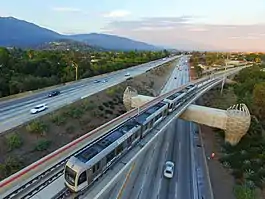A Line (Los Angeles Metro)
The A Line (formerly, from 1990 to 2019, and colloquially known as the Blue Line)[2][3] is a 48.5-mile (78.1 km)[1] light rail line in Los Angeles County, California. The A Line runs east-west between Azusa and Pasadena, then north-south between Pasadena and Long Beach, via Downtown Los Angeles.
The A Line is the oldest of six lines in the Los Angeles Metro Rail system, operated by the Los Angeles County Metropolitan Transportation Authority. The original Blue Line segment from Long Beach to Downtown Los Angeles opened in 1990, using much of the original right-of-way of the Long Beach Line, a former Pacific Electric interurban line.
The A Line's current Azusa–Long Beach service was introduced in June 2023 with the opening of the Regional Connector, incorporating the Union Station–Pasadena–Azusa portion of the former Gold Line.[4] The A Line is currently the longest light rail line in the world.[5]
Service description
Route description
The A Line runs 48.5 miles (78.1 km)[1] between Azusa and Downtown Long Beach, with 44 stations. It is the longest light rail line in the world.
The line's northern terminus is at APU/Citrus College station just west of Citrus Avenue and the two universities. The line runs west through Azusa before stopping at Azusa Downtown station at Azusa Avenue, north of Foothill Boulevard, near the downtown shops and government buildings.
Continuing west, the line crosses over the I-210 freeway and runs parallel to it, entering Irwindale before stopping at Irwindale station at Irwindale Avenue. After this station, the line continues west, crossing over the San Gabriel River and underneath the I-605 freeway, diverging from I-210 and entering Duarte, before stopping at Duarte/City of Hope station located on the north side of Duarte Road, across from the City of Hope National Medical Center.
Continuing west, the line parallels Duarte Road, entering Monrovia, before diverging northwest just before arriving at Monrovia station. In this area, the line runs adjacent to single-family homes. Entering Arcadia, the line crosses all street crossings on bridges except for First Avenue at the at-grade Arcadia station.
Continuing west, the line reconverges with and enters the median of I-210 and continues west to Sierra Madre Villa station in Pasadena. Six stations serve different parts of Pasadena, with three of them in the freeway's median. In Old Pasadena, the line travels underground for almost half a mile, passing under Pasadena's main thoroughfare, Colorado Boulevard, which makes the Memorial Park station below grade. The station serves most of Pasadena's fine dining, shops, malls, and civic center. The Pasadena City Hall is visible upon exiting the station. The line continues south through downtown Pasadena and South Pasadena, primarily at-grade.
North of Highland Park, the line crosses over the Arroyo Seco Parkway (State Route 110) via the grand Santa Fe Arroyo Seco Railroad Bridge towards Highland Park. After Highland Park station, the line runs in the median of Marmion Way, where trains go at only 20 miles per hour (32 km/h). After 50th Avenue, the line runs primarily at-grade in its own right-of-way, except for a short tunnel underneath the intersection of Figueroa Street and Pasadena Avenue.
From here, the line continues, with a handful of stations serving the hillside communities north of downtown, including Lincoln Heights, Mount Washington, and the Southwest Museum of the American Indian. Northeast of Chinatown, the line crosses over the Los Angeles River on an elevated viaduct. Continuing on the elevated viaduct, the line stops at Chinatown station before arriving at Union Station. This entire section of the line north of Union Station follows the current and former right-of-way of the Pasadena Subdivision.
At Union Station, riders can transfer to other trains and modes.
Transfers include:
- The B and D rapid transit lines.
- The J bus rapid transit line.
- Other bus services.
- Metrolink commuter rail.
- Amtrak inter-city services.
When the line used to be the L Line, trains went toward Atlantic station in East Los Angeles. Trains now use a new tunnel constructed via the Regional Connector Transit Project underneath downtown, which connects with the original A Line at 7th Street/Metro Center station. In Little Tokyo, the line enters the new tunnel north of Temple Street to serve the replacement underground Little Tokyo/Arts District station, where the line merges with the E Line. The lines turn to run under 2nd Street and the 2nd Street Tunnel, as well as the B and D lines, with clearances as low as 7 feet (2.1 m).
The new tunnel ends at the north end of 7th Street/Metro Center station, the previous terminal built in the early 1990s, and the line continues south under Flower Street. After rising to street level, the A and E Lines run south along Flower Street. Passengers can connect to the bus rapid transit J Line at 7th Street/Metro Center, Pico, and Grand stations. The two lines diverge at Flower Street and Washington Boulevard. E Line trains continue south along Flower Street. At the same time, the A Line turns east onto Washington Boulevard before turning south into the former Pacific Electric right-of-way at Long Beach Avenue. This historic rail corridor has four tracks, two for A Line trains and two for freight trains. Along the corridor, there are some flyovers to either eliminate grade crossings in more densely populated areas or pass over diverging freight tracks. Passengers can connect with the C Line at the Willowbrook/Rosa Parks station. Just south of Willow station, A Line trains exit the rail corridor and begin street running in the median of Long Beach Boulevard into the city of Long Beach, where trains travel through the Long Beach Transit Mall while making a loop using 1st Street, Pacific Avenue, and 8th Street.
Hours and frequency
A Line trains run every day between approximately 4:30 a.m. and 11:30 p.m. Trains operate every 10 minutes during peak hours Monday through Friday, and every twelve minutes during the daytime on weekdays and all day on the weekends. Evening service (after 7 p.m.) is every 20 minutes.[6]
| Time | 4-5A | 6-7A | 8A-1P | 2-6P | 7P | 8-11P |
|---|---|---|---|---|---|---|
| Weekdays | 10-21 | 10 | 12 | 10 | 10-20 | 20 |
| Weekends/Holidays | 20 | 10-20 | 12 | 20 | ||
Speed
As listed on the official timetable, trains take two hours to travel the 49.5-mile (79.7 km) length of the line,[7] an average speed of 24 miles per hour (39 km/h).
Station listing
The following is the complete list of stations, from north to south.
| Station | Date Opened | City/Neighborhood | Major connections and notes[8][9] |
|---|---|---|---|
| APU/Citrus College | March 5, 2016 | Azusa | Park and ride: 200 spaces |
| Azusa Downtown | Park and ride: 521 spaces | ||
| Irwindale | Irwindale | Park and ride: 350 spaces | |
| Duarte/City of Hope | Duarte | Park and ride: 125 spaces | |
| Monrovia | Monrovia | Park and ride: 350 spaces | |
| Arcadia | Arcadia | Park and ride: 300 spaces | |
| Sierra Madre Villa | July 26, 2003 | Pasadena | Park and ride: 965 spaces |
| Allen | |||
| Lake | Park and ride: 22 spaces | ||
| Memorial Park | |||
| Del Mar | Park and ride: 610 spaces | ||
| Fillmore | Park and ride: 155 spaces | ||
| South Pasadena | South Pasadena | Park and ride: 142 spaces | |
| Highland Park | Los Angeles (Highland Park) | ||
| Southwest Museum | Los Angeles (Mount Washington) | ||
| Heritage Square | Los Angeles (Montecito Heights) | Park and ride: 129 spaces | |
| Lincoln/Cypress | Los Angeles (Lincoln Heights/Cypress Park) | Park and ride: 94 spaces | |
| Chinatown | Los Angeles (Chinatown) | ||
| Union Station | Los Angeles (Downtown) | Paid parking: 3,000 spaces | |
| Little Tokyo/Arts District | November 15, 2009 | Los Angeles (Little Tokyo/Arts District) | |
| Historic Broadway | June 16, 2023 | Los Angeles (Downtown) | |
| Grand Avenue Arts/Bunker Hill | |||
| 7th Street/Metro Center | February 15, 1991 | ||
| Pico | July 14, 1990 | ||
| Grand/LATTC | |||
| San Pedro Street | South Los Angeles | ||
| Washington | |||
| Vernon | |||
| Slauson | |||
| Florence | Florence-Graham | Park and ride: 116 spaces | |
| Firestone | |||
| 103rd Street/Watts Towers | Watts | Park and ride: 64 spaces | |
| Willowbrook/Rosa Parks station | Willowbrook | Park and ride: 234 spaces | |
| Compton | Compton | ||
| Artesia | Park and ride: 288 spaces | ||
| Del Amo | Carson | Park and ride: 362 spaces | |
| Wardlow | Long Beach | Park and ride: 139 spaces | |
| Willow Street | Park and ride: 927 spaces | ||
| Pacific Coast Highway | |||
| Anaheim Street | |||
| 5th Street (southbound only) |
September 1, 1990 | ||
| 1st Street (southbound only) |
|||
| Downtown Long Beach (northbound only) |
|||
| Pacific Avenue (northbound only) |
Ridership
| Year | Ridership | %± |
|---|---|---|
| 2009 | 25,735,979 | — |
| 2010 | 25,119,753 | −2.4% |
| 2011 | 26,053,645 | +3.7% |
| 2012 | 28,959,483 | +11.2% |
| 2013 | 28,185,745 | −2.7% |
| 2014 | 27,276,468 | −3.2% |
| 2015 | 24,457,253 | −10.3% |
| 2016 | 24,988,825 | +2.2% |
| 2017 | 22,383,828 | −10.4% |
| 2018 | 19,836,016 | −11.4% |
| 2019 | 8,905,140 | −55.1% |
| 2020 | 9,290,318 | +4.3% |
| 2021 | 9,099,416 | −2.1% |
| 2022 | 10,663,617 | +17.2% |
| Source: Metro[10] | ||
History
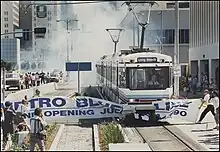

Long Beach Line
Much of the current A Line follows the route of the Pacific Electric's Long Beach Line, which ended service in 1961. The old route gave the new light rail trains a private right-of-way between Washington and Willow Street stations allowing them to reach higher speeds between stops.[11]
The line initially opened as the Blue Line on Saturday, July 14, 1990, for US$877 million (equivalent to $1.96 billion in 2022 adjusted for inflation),[7] and ran from Pico to Anaheim Street. The Long Beach Loop section to Long Beach opened in September 1990,[12] followed by the tunnel into 7th Street/Metro Center in February 1991.
The route was a success, and from 1999 to 2001, the Blue Line underwent a US$11 million project to lengthen 19 of its platforms so that they could accommodate three-car trains.[13] Plans were also made to extend the Blue Line north to Pasadena, but the connection across downtown was deferred, and the northern portion opened as the Gold Line in 2003. That original plan for the Blue Line became a reality when the Regional Connector was announced in 2009. Ground was broken for the Regional Connector across downtown in 2014, and it opened on June 16, 2023.[14]
The Blue Line was renovated in 2019, with the southern half of the line being closed for the first five months and the northern half closing for the following five months (10 months total). Metro provided a bus shuttle service to compensate for the lack of rail service. Metro officially reopened the line on November 2, 2019, rebranding it as the A Line.[2][3][15]
Pasadena Blue Line

Much of the L Line's right-of-way through the San Gabriel Valley was built by the Los Angeles and San Gabriel Valley Railroad in 1885, eventually taken over by the Atchison, Topeka and Santa Fe Railway, as part of the Pasadena Subdivision, which saw Amtrak service until 1994, when construction began on the conversion to light rail. The project was initially called the "Pasadena Metro Blue Line." Planners envisioned extending the existing Blue Line from Long Beach. Still, when a ban on sales tax spending on subway tunnels passed in 1998, the project became a separate line terminating at Union Station.[4]
The now-renamed Gold Line, between Union Station and Sierra Madre Villa station in East Pasadena, opened on July 26, 2003.
Foothill Extension
Phase 2A (the section between LA and Pasadena was Phase 1) of the Foothill Extension, running between Sierra Madre Villa and APU/Citrus College station in Azusa, opened on March 5, 2016.
Regional Connector
The Regional Connector Transit Project constructed a 1.9-mile (3.1 km) light rail tunnel across Downtown Los Angeles that connected the L Line with the A and E lines. The project finally completed the late 1990s vision of the "Pasadena Blue Line," connecting the northern (Union Station–Azusa) segment of the L Line to the A Line (formerly the Blue Line), which ran between Los Angeles and Long Beach. The southern (Pico/Aliso–East LA) segment was combined with the existing E Line between Downtown Los Angeles and Santa Monica. The new east–west line kept the E Line name but uses the L Line's gold color.
The at-grade Little Tokyo/Arts District station was demolished in 2020 and was rebuilt as a subway station approximately 500 feet (150 m) south and on the opposite side of Alameda from its former location.
With this project completed, service was simplified into the following configuration:[16]
- A Line
- The northeastern segment of the L Line (north of Little Tokyo/Arts District) became an extension to the previously existing A Line.
- The Foothill Extension Project was also absorbed into the A Line, which would extend it further to Pomona–North station upon its completion in summer 2025.[17]
- E Line
- The southern portion of the current L Line to the Eastside was combined with the existing E Line, which kept the E Line name but now uses the L Line's gold color.
The groundbreaking for constructing the Regional Connector occurred on September 30, 2014, and opened on June 16, 2023.[14]
Future developments
Foothill Extension
Phase 2B of the Foothill Extension, running between APU/Citrus College station in Azusa and the Pomona–North Metrolink station in Pomona, is currently under construction, with a current estimated completion of summer 2025.[17] This extension, like the original Gold Line to Pasadena, and the first phase of the Foothill Extension is being built by a specialized construction authority, independent of Metro. The original plan called for the extension to end at Montclair in San Bernardino County, but budget challenges forced the construction authority to cut the line back to Pomona.
It is served by the A Line due to the completion of the Regional Connector project on June 16, 2023.[14]
WASB
Main Article: West Santa Ana Branch Transit Corridor
The West Santa Ana Branch Transit Corridor is a planned light rail line, mostly following the Pacific Electric's historic West Santa Ana Branch, connecting Downtown Los Angeles to the city of Artesia, along with other cities in southeastern Los Angeles County. It will link the southeast/Gateway cities with the A line at Slauson station (A Line) station. It is to start construction in 2025 and operate starting in 2035. Metro says it will take 10 years to build.
Current issues
Capacity limits
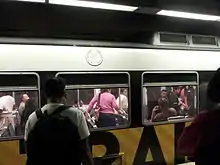
The line often operates at capacity, and various options to increase capacity have been considered, such as four-car or more frequent trains. Both have problems: it would be difficult or impossible to lengthen some of the station platforms, and the number of trains already causes delays for other vehicles at level crossings. Thus it may not be possible to increase A Line ridership without a costly grade-separation project, either by elevation, by an entrenchment method similar to that used by the nearby Alameda Corridor freight rail "expressway," or by building another parallel transit corridor to relieve capacity strains from the A Line. With the Regional Connector Transit Project linking the A and E Line tracks with the former L Line tracks in Little Tokyo, this may result in even more capacity problems, with ridership expected to grow. Pico station, which is served by both A and E line trains, is a major limiting factor for service frequency. The very busy grade crossing immediately adjacent to the station makes reliably running high-frequency service on both lines logistically very difficult.
Safety at level crossings
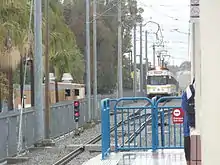
Over 120 motorists and pedestrians have been killed at A Line level crossings since 1990. There have been more than 800 collisions,[18][19] making the line easily the country's deadliest and most collision-prone rail line.[20]

In 1998, the MTA commissioned Booz Allen Hamilton, Inc. to evaluate the cause of Blue Line collisions and recommend affordable solutions. The study reported the high ridership (over 70,000 per day) was a contributor:
The MBL has one of the highest ridership counts for light rail lines in the Country. This factor is perhaps the most important contributor to the grade-crossing accident rate. The high ridership results in increased pedestrian traffic near stations compared to other light rail systems. In addition, although MTA Operations does not allow high passenger loads to dictate safe operations, there is pressure to maintain travel times and headway schedule requirements (e.g., a passenger trip from Los Angeles to Long Beach in less than one hour).
Other contributing factors identified were the high population density leading to more pedestrian and vehicular traffic around the tracks, the diverse varied socio-economic community around the line that creates literacy and language difficulties for public education campaigns, driver frustration due to the slow traffic speeds around the line that leads to more risk-taking behavior, and the shared right-of-way with freight traffic in the fastest running section from Washington station to Willow station, where trains operate at a maximum of 55 mph (89 km/h) between stations.
The collision rate has declined somewhat following the installation of four-quadrant gates at some crossings where the A Line shares the right-of-way with freight rail between Willowbrook station and Artesia station. The gates prevent drivers from going around lowered gates. In addition, cameras along some problem intersections issue traffic tickets when drivers go around gates.
Operations
On Metro Rail's internal timetables, the A Line is called line 801.
Because of the length of the line, operators do not take trains from end to end, swapping out at Union Station. Trains are operated between APU/Citrus College and Union Station by employees based at Division 24 in Monrovia. Between Long Beach and Union Station, operators are based out of Division 11 in Rancho Dominguez.[21]
Maintenance facilities
The A Line is operated out of two divisions, Metro’s term for train maintenance and storage facilities.
Division 11 is located at 4350 East 208th Street in Cota, North Long Beach between Del Amo and Wardlow stations. The facility can house and maintain 86 light rail vehicles and can perform heavy maintenance including repainting. Trains get to this yard via a wye junction on the southbound tracks. Northbound trains can enter and exit the yard via the cross tracks on the north and south side of the junction.
Division 24 is located south of the I-210 freeway in Monrovia between Monrovia and Duarte/City of Hope stations. Just like Division 11, trains access the yard via the westbound/southbound tracks from either direction of its wye junction. Crossovers from the eastbound track to the yard junction are located near the California Avenue and Mountain Avenue railroad crossings.
Rolling stock
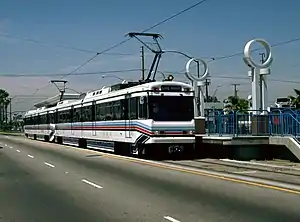
The A Line operates trains with three light rail vehicles on weekdays and two on weekends.[21] The line currently uses three different types of light rail vehicles: the Siemens P2000, the Kinki Sharyo P3010 and the AnsaldoBreda P2550, but has seen every type light rail rolling stock on Metro's roster throughout its history of operation.
When the A Line, then known as the Blue Line, first opened in 1990 the line had 54 Nippon Sharyo P865 light rail vehicles, numbered 100–153. These cars wore a unique livery consisting of several blue stripes and a single red stripe, reflecting the Blue Line's color designation and its Pacific Electric Red Car heritage.
In 2000, Metro transferred all 15 Nippon Sharyo P2020 (numbered 154-168) light rail vehicles from the Green Line (now the C Line) to the Blue Line fleet. These light rail vehicles were nearly identical to the older P865 model but were about five years newer and originally had equipment for automatic train operation.[22]
In 2012, Metro transferred some Siemens P2000 light rail vehicles from the Gold Line to the Blue Line fleet.
In 2017, the Blue Line received 78 Kinki Sharyo P3010 light rail vehicles, the first new cars for the line since it opened in 1990. As the P3010 fleet was introduced, Metro gradually retired all of the remaining P865 light rail vehicles, followed by the P2020 fleet.
In 2023, as a result of the completed Regional Connector, the AnsaldoBreda P2550 light rail vehicles started running the original Blue Line route. They originally test ran the Blue Line back in 2009 before becoming exclusive to the Gold Line. Originally, the P2550s were unable to run along the Blue Line due to weight restrictions.
References
- "Facts At A Glance". Los Angeles County Metropolitan Transportation Authority. June 2023. Archived from the original on March 19, 2023. Retrieved June 22, 2023.
- Fonseca, Ryan (September 25, 2019). "Ignore Those 'Line A' Signs. Metro's Blue Line Will Reopen As The 'A Line'". laist.com. Southern California Public Radio. Archived from the original on September 26, 2019. Retrieved September 26, 2019.
- "Light rail to Long Beach will reopen soon — but it won't be called the Blue Line". Los Angeles Times. October 17, 2019. Archived from the original on October 18, 2019. Retrieved October 18, 2019.
- "LA Metro celebrates opening three new stations connecting the mountains to the beaches". CBS News. June 16, 2023. Retrieved July 27, 2023.
- Morino, Douglas (June 23, 2023). "L.A. Opens Its New Light-Rail Link". The New York Times. Retrieved July 26, 2023.
- "Metro A Line schedule". Los Angeles County Metropolitan Transportation Authority. June 16, 2023. Retrieved June 12, 2023.
- "Facts at a Glance". Los Angeles County Metropolitan Transit Authority. November 18, 2013. Archived from the original on August 20, 2019. Retrieved November 16, 2013.
- "Metro A Line (Blue)". www.metro.net. Archived from the original on September 28, 2020. Retrieved July 23, 2020.
- "Metro Parking Lots by Line". www.metro.net. Archived from the original on August 10, 2020. Retrieved July 23, 2020.
- "Metro Ridership". Metro.net. Los Angeles County Metropolitan Transportation Authority. March 2023. Archived from the original on April 10, 2021. Retrieved March 10, 2023.
- Reft, Ryan (February 26, 2015). "A Clear Blue Vision: L.A. Light Rail Transit and Twenty-Five Years of the Blue Line". KCET. Archived from the original on February 8, 2021. Retrieved February 8, 2021.
- "New Long Beach Loop". The Los Angeles Times. September 1, 1990. p. B10. Archived from the original on March 23, 2023. Retrieved December 14, 2022 – via Newspapers.com.

- "MTA Starts 3-Car Train Service on Busy Metro Blue Line". www.metro.net. Archived from the original on June 3, 2021. Retrieved January 22, 2020.
- Von Quednow, Cindy (June 16, 2023). "Metro Regional Connector opens in Los Angeles, bringing more direct access to downtown". KTLA. Nexstar Media Group. Retrieved June 16, 2023.
- "A Line". www.metro.net. Archived from the original on October 18, 2019. Retrieved November 18, 2019.
- "The most anticipated transit projects opening in time for the 2028 LA Olympics". Curbed LA. Archived from the original on November 25, 2018. Retrieved November 25, 2018.
- @numble (October 3, 2023). "August 2023 status report for LA Metro's Foothill Gold Line (Blue/A) Extension. 72.9% complete as of 8/31/23 +1.5% since 5/31/23 (3 month period). Potential typos in report (it says 72.9% as of June)" (Tweet). Retrieved October 3, 2023 – via Twitter.
- Nelson, Laura (March 28, 2015). "Metro light rail crash near USC renews debate on rail safety". Los Angeles Times. Archived from the original on October 19, 2015. Retrieved October 20, 2015.
- "Summary of Blue Line Train/Vehicle and Train/Pedestrian Accidents". Los Angeles County Metropolitan Transportation Authority. June 2007.
- "Light rail fatalities, 1990–2002". American Public Transportation Association. May 20, 2005. Archived from the original on September 26, 2010. Retrieved May 12, 2010.
- "Regional Connector Slides for Customer Service Briefings". Los Angeles County Metropolitan Transportation Authority. Retrieved June 21, 2023.
- "Archived copy". Archived from the original on October 25, 2007. Retrieved October 22, 2007.
{{cite web}}: CS1 maint: archived copy as title (link)
External links
- Los Angeles County Metropolitan Transportation Authority
- Blue Line homepage Archived January 16, 2010, at the Wayback Machine
- Blue Line schedule Archived June 25, 2013, at the Wayback Machine
- Blue Line connections overview
- A History of the Blue Line: A Light Rail Success Story Archived July 29, 2007, at the Wayback Machine by the Transit Coalition
- Killing Time on the Ghetto Blue from the LA Weekly
- Delivery of The First Metro Blue Line Vehicle

